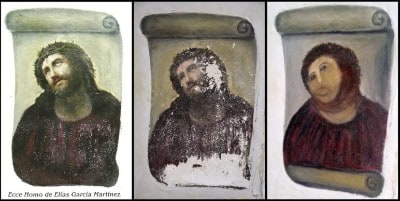How Art Restoration Increases The Value Of Your Antique Art
How Art Restoration Increases The Value Of Your Antique Art
By Bernard Mumford
For a lot of people, the words “art restoration” in relation to their favorite or incredibly sentimental heirloom artwork can be a pretty frightening thought. Trust some “art restorer” to enhance my rare or prized artwork? I think not!
Unfortunately, in some cases that’s a pretty wise opinion. The most famous real world art restoration disaster occurred in Borja, Spain five years ago when an amatuer artist turned a Sanctuary of Mercy church fresco of Jesus called Ecce Homo (Behold the Man) into a cartoonish mess now jokingly referred to as Ecce Mono (Behold the Monkey). The Sanctuary of Mercy salvaged the situation by turning the ruined fresco into a tourist attraction to raise money for local charities, but the fresco is forever ruined.

When you’ve got a piece of artwork that’s fallen victim to the ravages of time, hearing horror stories like these can make you feel it’s better not to have your piece restored, but the longer you wait to restore that piece of art the harder it will be for a qualified restorer to return it to like-new condition.
Fortunately, it doesn’t have to be that way. Here are some ways that professional art restoration from Mumford Restoration can bring new life (and increased value) to your careworn artwork:
Examination & Appraisal
If you have antique art in your home, it’s important to remember that the materials the artist used weren’t designed to stand the test of time. Paints may have been made with ingredients that are now known to be dangerous; varnishes yellow with age; and colors degrade and fade over time. These issues need to be resolved before the piece degrades too far to be saved.
When you schedule a free art restoration estimate with Mumford Restoration, we will perform a 23-point inspection of the piece and provide a fair market value appraisal. We’ll then explain the four levels of restoration service we have available and our suggestions for reaching the optimal condition.

Restoration
Based on our estimate and advice, you will choose the right level of restoration for your art piece.
Bronze
Full Cleaning Ozone to remove odor, disassemble, clean inside and out, reassemble, wrap with paper and inventory label.
Silver
Refurbish Ozone to remove odor, disassemble, discard acidic materials, full cleaning, replace glass, art dry mounted or hinge mounted, digital scan, cut new non-acidic mat, touch up frame, install art, new paper backing and new hardware, wrap with paper and inventory label.
Gold
Restoration Ozone to remove odor, disassemble, discard acidic materials, full cleaning, treat foxing, stretch artwork if needed, revarnish, digital scan, new backboard, replace liner, restore or replace frame, gold rubbing or glazing, install art, new paper backing, new hardware, wrap with paper and inventory label.
Platinum
Conservation Ozone, disassemble, full cleaning, restore art, treat foxing, repair holes or tears, restretch or relining, in-painting, revarnish, restore or replace frame, recast missing relief work, replace liner, gold or silver leafing, install art, new paper backing, new hardware, wrap with paper and inventory label.

Reappraisal
When your art restoration is complete our professional art conservator will give you a new appraisal based on the piece’s history and newly restored condition. In some cases, especially with family heirloom pieces, the sentimental value of the piece far outweighs the cash value. For other pieces, like gallery pieces destined for auction, the cash value is significantly increased with restoration.
Don’t Let Restoration Horror Stories Scare You Off. Call Mumford Restoration for Professional Art Restoration! (919) 510-6310
About
About the author: Bernard Mumford
Bernard has been restoring antiques for over 40 years. He loves building, repairing, and experimenting with finishes and has passed this love of antiques down to his children--two of whom work full time at Mumford Restoration! If you have a question about what kind of wood your furniture is made of, what the style is, and when it was made, Bernard's the person to ask! He has a nearly encyclopedic knowledge of furniture and he's always happy to chat with curious antique owners!
Learn MoreRelated
Reduce Liability & Restore Value with Specialty Contents Experts
The carpet squelches when you walk on it, there are soot stains on every surface, and the homeowner...By Stephanie Clough
How Art Restoration Preserves Women’s History
How long before flowers wilt in a basement? In the case of the oil painting “Enchantment,” not even...By Stephanie Clough

